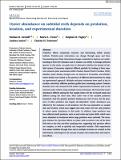Por favor, use este identificador para citar o enlazar a este item:
http://hdl.handle.net/10261/282598COMPARTIR / EXPORTAR:
 SHARE SHARE
 CORE
BASE CORE
BASE
|
|
| Visualizar otros formatos: MARC | Dublin Core | RDF | ORE | MODS | METS | DIDL | DATACITE | |

| Título: | Oyster abundance on subtidal reefs depends on predation, location, and experimental duration |
Autor: | Geraldi, Nathan R.; Vozzo, María L.; Fegley, Stephen R.; Anton, Andrea CSIC ORCID; Peterson, Charles H. | Palabras clave: | Biogenic habitat Body size Environmental gradients Food web In situ experiment Intraguild predation Oyster reef Special Feature: Honoring Charles H. Peterson Ecologist |
Fecha de publicación: | jun-2022 | Editor: | John Wiley & Sons | Citación: | Ecosphere 13(6): e4087 (2022) | Resumen: | Predation affects community structure and functioning within marine habitats. Predator–prey interactions can change through space and time. Documenting how these interactions change is essential to improve our understanding of food web dynamics and to enhance our ability to manage preferred species. In this study, our goals were to determine whether the density of subtidal oysters (Crassostrea virginica) differed spatially by looking at three separate restored oyster sanctuaries within Pamlico Sound (North Carolina, USA), whether oyster density changed over an interval of 16 months, and whether oyster density was related to the presence of different-sized predators by using an experimental approach. Multiple exclusion treatments were used in situ to exclude, selectively, different predator guilds from consuming oysters. Predator densities were also measured both within experimental treatments and on the restored oyster reefs by using multiple survey techniques. We found that oyster abundance differed among the four sample dates over the 16-month study and differed among the three sites. Mud crabs—one of the smallest predators measured—had the greatest predator biomass per unit of area, but the presence of other predators was largely site-dependent. Oyster abundance was affected by the exclusion of all predators, but this was dependent on sample date and location, which may suggest that mud crabs were the only predator to reduce oyster abundance in this study. In addition, large predators may have affected small predators, such as mud crabs and oyster drills, which were more abundant in treatments where large predators were excluded. The strongest evidence for top-down effects on oyster reefs occurred at one of the three field sites at the first and final sampling time, suggesting that predator effects are complex, as well as spatially and temporally variable. Field experiments that assess variables through time and at multiple locations are needed as this information could improve the success of oyster reef conservation and restoration efforts. | Versión del editor: | http://dx.doi.org/10.1002/ecs2.4087 | URI: | http://hdl.handle.net/10261/282598 | DOI: | 10.1002/ecs2.4087 | Identificadores: | doi: 10.1002/ecs2.4087 issn: 2150-8925 |
| Aparece en las colecciones: | (IMEDEA) Artículos |
Ficheros en este ítem:
| Fichero | Descripción | Tamaño | Formato | |
|---|---|---|---|---|
| Oyster-abundance.pdf | 2,19 MB | Adobe PDF |  Visualizar/Abrir |
CORE Recommender
SCOPUSTM
Citations
4
checked on 30-abr-2024
WEB OF SCIENCETM
Citations
4
checked on 29-feb-2024
Page view(s)
34
checked on 07-may-2024
Download(s)
90
checked on 07-may-2024
Google ScholarTM
Check
Altmetric
Altmetric
Este item está licenciado bajo una Licencia Creative Commons

